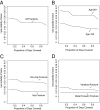The complex relation between bisphosphonate adherence and fracture reduction
- PMID: 20444916
- PMCID: PMC2928897
- DOI: 10.1210/jc.2009-2778
The complex relation between bisphosphonate adherence and fracture reduction
Abstract
Context: Real-world adherence to bisphosphonate therapy is poor. Consistent data support a relation between medication adherence and fracture reduction, but relatively little attention has been paid to the effect of the method used to measure adherence on this relation or on the relation between adherence and specific fracture types.
Objective: Our objective was to assess the relation between bisphosphonate adherence and the risk of hip, vertebral, distal forearm, and any fracture using different measures of adherence.
Design: We conducted a cohort study using administrative claims data. Adherence was assessed in sequential 60-d periods. In models incorporating time-varying measures of adherence, the adjusted relation between adherence and fracture was examined using several methods for calculating the proportion of days covered (PDC).
Patients: Patients included community-dwelling elderly enrolled in a Pennsylvania pharmaceutical assistance program and Medicare initiating an oral bisphosphonate for osteoporosis.
Main outcome measures: Risk of hip, vertebral, distal forearm, and any osteoporotic fracture was assessed.
Results: Fractures occurred at a rate of 43 per 1000 person-years among the 19,987 patients meeting study eligibility criteria. There was an inverse relation between adherence and fracture rate for all adherence measures and fracture types, excluding distal forearm fractures. High (80-100%) cumulative PDC was associated with a 22% reduction in overall fracture rate, a 23% reduction in hip fracture rate, and 26% reduction in vertebral fracture rate.
Conclusions: We found a consistent relation between adherence with osteoporosis treatment and fracture reduction, regardless of method for measuring PDC. The similarity in results across adherence measures is likely due to the high correlation between them.
Figures


References
-
- Burge R, Dawson-Hughes B, Solomon DH, Wong JB, King A, Tosteson A 2007 Incidence and economic burden of osteoporosis-related fractures in the United States, 2005–2025. J Bone Miner Res 22:465–475 - PubMed
-
- Cranney A, Guyatt G, Griffith L, Wells G, Tugwell P, Rosen C 2002 Meta-analyses of therapies for postmenopausal osteoporosis. IX. Summary of meta-analyses of therapies for postmenopausal osteoporosis. Endocr Rev 23:570–578 - PubMed
-
- Kothawala P, Badamgarav E, Ryu S, Miller RM, Halbert RJ 2007 Systematic review and meta-analysis of real-world adherence to drug therapy for osteoporosis. Mayo Clin Proc 82:1493–1501 - PubMed
-
- Ström O, Borgström F, Kanis JA, Jönsson B 2009 Incorporating adherence into health economic modelling of osteoporosis. Osteoporos Int 20:23–34 - PubMed
-
- Hughes DA, Bagust A, Haycox A, Walley T 2001 The impact of non-compliance on the cost-effectiveness of pharmaceuticals: a review of the literature. Health Econ 10:601–615 - PubMed
Publication types
MeSH terms
Substances
Grants and funding
LinkOut - more resources
Full Text Sources
Medical

